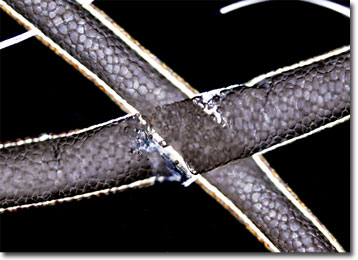Polarized Light Microscopy Digital Image Gallery
Deer Hair
Deer are ruminants belonging to the family Cervidae, the males of which usually exhibit prominent antlers. These antlers are shed and regrown each year, reaching their largest size during the height of rutting season.

Native to most regions of the world with the exception of Australia, deer are herbivores that consume grass, bark, twigs, and similar items. In some areas, certain species of the mammals must carry out extended migrations on an annual basis in order to ensure adequate food levels. Typically gregarious, most deer migrate and live in family groups, but males may become solitary and erratic in behavior seasonally. In fact, it is not uncommon for males to enter into vicious battles when competing for mates. Such fights generally involve the aggressive use of hooves and antlers, though tusk-like canine teeth are utilized by muntjacs and other deer species that do not posses antlers.
Deer pelts are usually tawny or brown in color and are often highlighted with white patches along the throat and chest. The fur of many young deer often feature white spotting as well. Though it often appears soft and smooth to the eye, especially from a distance, deer hair is relatively coarse. The natural fiber is not, therefore, very popular in the textiles market. Indeed, deer are much more often sought by humans for their meat, which is referred to as venison, their hides, which can be tanned into soft leather, and their antlers, which serve as hunting trophies in many parts of the world but are also utilized for medicinal purposes in China.
